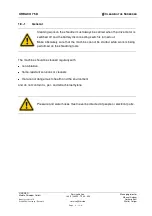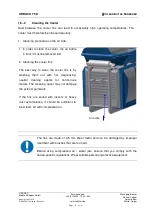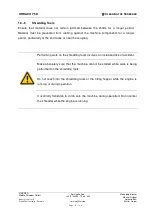
URRACO 75 D
C
LEANING THE
S
HREDDER
Managing director
LINDNER
Mobile Shredder GmbH
Industriestrasse 1A
D-99820 Hörselberg / Eisenach
Service hotline:
+49 (0) 36920 - 7269 - 600
Manuel Lindner
Gerhard Buhl
Walter Geiger
Page - 6 - of - 8 -
Cleaning procedure on the water side:
Cooler soiling on the water side can be caused, on one hand, by rust deposits, grease or
other water impurities, or, on the other, by scale deposits resulting from the use of hard
water.
In order to clean the inside of the cooler from rust, grease, etc., it should be sufficient to rinse
the unit thoroughly while adding a degreasing agent to the cooling water as described above.
The rinsing procedure must be carried out with hot fluid and while the engine is running.
To remove scaling, dismount the cooler. A commercially available, non-acidic agent can be
used, which must not corrode the cooler materials (cooper, brass, and tin/lead solders).
In case of more intense incrustation, mild acidic cleaning agents may be used (e.g.
containing sulfamic acid, formic acid).
However, the cleaning agents must contain benzine inhibitors in order to reduce metal
dissolution.
Please note, however, that these mild acidic cleaning agents are very aggressive and
therefore should only be used with great caution. Cleaning these coolers should preferably
be done by an expert.
It is advised not to use stronger acids, or the aforementioned mild acids in
higher concentrations, since this most often will cause the cooler itself to
dissolve.
After cleaning with acidic or alkaline cleaning agents, the coolers must always
be rinsed immediately and several times with pure water. If the cooler has not
been dismounted, the engine must run in order to completely rinse acid
residues from the entire cooling system.
If the cooler tubes are heavily clogged, the cooler cannot be cleaned by flushing with
solvents. In this case, the cooler must be cleaned mechanically by a cooler system expert or
the manufacturer. The safest option, however, is a new radiator block.


























